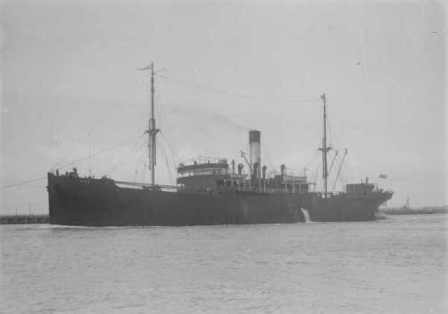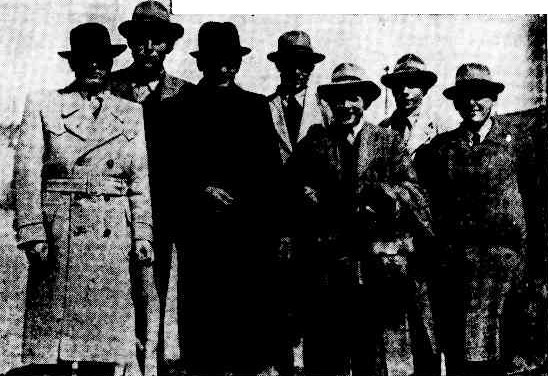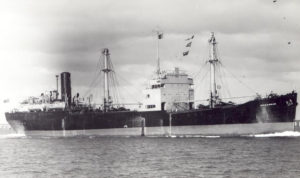While I previously focused on the Incharran (because it was active a fortnight before the Somerton Man’s death), it was Hong Kong-owned and seems to have had an almost entirely Chinese crew: and given that few would argue that the Somerton Man seemed even remotely Asian (a “Britisher” was one description used), it does seem a little unlikely that our mystery man will turn out to have been working on the Incharran.
Yet the Electrolytic Zinc Company of Australasia had a second boat plying the same zigzaggy zinc-and-lead trade route, the SS Era. I hadn’t properly considered the SS Era before because the timing seemed slightly wrong: but given that Byron Deveson now suspects that the Somerton Man’s exposure to lead could well have happened as far back as four or even five weeks before his death, the SS Era swings back into our frame and so seems well worth a close look.
The SS Era
An earlier ship called the Era was torpedoed in the Mediterranean in 1918: but we’re interested in the SS Era built in 1921 on Clydeside, and then bought in Glasgow by Australian Steamships Pty Ltd (Howard Smith Ltd), Melbourne.
I only managed to dig up a single photograph of the correct Era on this page on Howard Smith’s ships:
Whereas the Incharran was a beefy former Empire ship, I suspect that by 1948 the Era was perhaps a little long in the teeth for an interstate freighter: in 1955, she was sold “to an Eastern buyer” and then scrapped in Hong Kong.
Log Books
The ever-helpful Log of Logs volume 1 lists where many of the Era’s log books ought to be found:
1926 – 1954
13 Official logs, 1926, 1930, 1937, 1939, 1944 * AA, SA, D13;
+ 29 Official logs, 1929-41, 1945-54 * AA, Syd, SP2, SP290, & SP989;
+ Official log, 18.12.1945 – 19.6.1946 * Australian Archives, Melb, MP 49/7;
+ 6 Off.logs, 1939-40, 1942, 1949, 1951-4. ex Newcastle * AA, Syd, SP458, 528.
However, when I went a-looking for these today, the NAA’s online catalogue only seems to contain the following SS Era log books from the 1940s:
448208: SP290/2 1940/ERA/1: ERA official log book 24 April 1940 – 28 May 1940 [Box 5]
448210: SP290/2 1940/ERA/2: ERA official log book 22 May 1940 – 19 November 1940 [Box 5]
448211: SP290/2 1941/ERA/1: ERA official log book 11 June 1941 – 20 November 1941 [Box 17]
448206: SP290/2 1941/ERA/2: ERA official log book 21 November 1941 – 17 June 1942 [Box 17]
745465: C12 NN: Era Official Log Book 18/6/1942 – 21/12/1942 [Box 32]
448208: SP290/2 1945/ERA/1: ERA official log book 29 June 1945 – 17 December 1945 [Box 62]
448207: SP290/2 1946/ERA/1: SS ERA official log book 20 June 1946 – 27 November 1946 [Box 75]
(SP2/1 covers 1930 to 1939 and also includes some of Era’s wireless logs, while MP102/1 covers 1950.)
Unfortunately, even though NAA’s SP989/1 (held in Sydney) does index numerous logbooks (AEON, FIONA, MANUNDA, etc), the SS Era wasn’t listed there. My guess is that nobody has yet asked to have a look at these, and so they haven’t yet been added to the NAA’s Big Fat Online Index Of Everything. I’ve put in a request to have these indexed, so that if they do happen to cover (say) Oct 1948 to Dec 1948, we can go in and have a look. 🙂
However, I did find other things in the NAA that were related to the SS Era:-
3006282: SP958/1, NN: Agreement and Account of Crew, ERA, 27 April 1948 to 10 November 1948 [25 pages; box 76]
3006283: SP958/1, NN: Agreement and Account of Crew, ERA, 11 November 1948 to 8 May 1949 [27 pages; box 76]
7937709: SP461/1, ERA: S S Era – inspection of crew accommodation [Box 1]
In the (hopefully temporary) absence of logbooks I’ve ordered up electronic copies of 3006282 and 3006283 from the NAA, so we shall see what they contain within 30 days, all being well…




